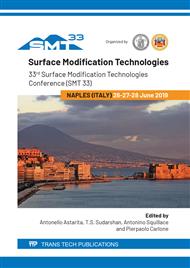p.376
p.381
p.387
p.393
p.399
p.404
p.411
p.417
p.423
Surface Induction Hardening of Steels: Process Modelling and Numerical Simulation
Abstract:
Heat treatments are widely used in industry to improve the surface behavior of components exposed to external mechanical actions and, therefore, undergoing wear phenomena. If compared to the conventional thermal treatments, induction hardening is an interesting candidate solution when the effect should be limited to the surface without affecting the microstructure and properties at the material core. Furthermore, this solution is appealing considering energy saving and cost reduction. In this process, an intense electric alternating current flows through a conductive coil enveloping the component to be treated. Such current generates a magnetic field and, as a consequence, eddy currents arise in the conductive work-piece providing a heat generation by the Joule effect. Due to this mechanism, the induction heating is characterized by faster heating rates with respect to the heating in a hot furnace. On the other hand, the induction hardening process requires a more challenging control of the operative parameters, namely the current density and frequency and the coil advancing speed. Numerical modeling and simulation are recognized as a very useful tool to predicting the effects induced by a treatment, avoiding undesired insufficient- or over-heating. The present work deals with a finite element numerical approach to the simulation of an induction hardening treatment of a steel component. The model is based on the subsequent solution of two numerical submodels. Firstly, the electro-magnetic field generated by the current flowing through a coil surrounding the processing part is inferred solving the Maxwell governing equations. Then, the magnetic field is used as input load for the subsequent heat transfer transient finite element model. The influence of the current density and frequency as well as other processing parameters on the magnetic and thermal fields is discussed.
Info:
Periodical:
Pages:
399-403
Citation:
Online since:
July 2019
Authors:
Price:
Сopyright:
© 2019 Trans Tech Publications Ltd. All Rights Reserved
Share:
Citation:


